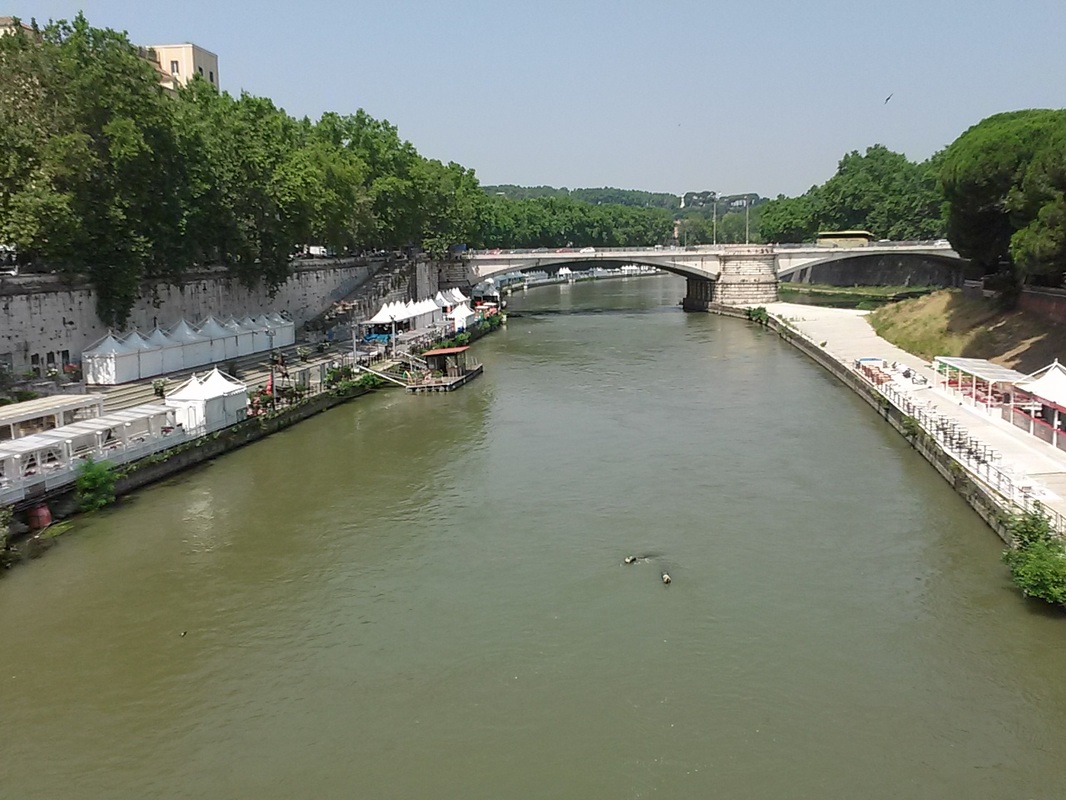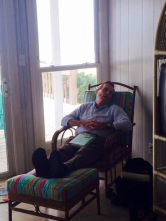Right now water and shade are the most precious commodities in Rome. Hence, a picture of the Tiber with its canopied cafes.
For the past ten days, noontime temperatures have climbed into the mid-nineties, and by mid-afternoon the sun leaves the entire city limp and wrung-out with fatigue and sweat. On the good days a breeze snatches away some of this heat for a few moments. The streets themselves offer a humorous commentary on this heat wave. The sunny side of any street is empty of pedestrians; the shaded side is a mob of tourists and locals. The fountains are plundered for their cool water, and the sidewalk cafes on the shady side of the street sell gelato to customers trying to cool off.
As for me, I generally leave my air-conditioned room by 9:30. Within five minutes, I have broken a sweat. Fifteen minutes more, and the perspiration pours out of me, soaking my shirt and leaving me wiping my face every five minutes or so. Because I walk Rome rather than take public transportation, I also seek the shady side of the street, which means bouncing around pedestrians on every block.
Yesterday I went to the Palazzo Barberini, where I enjoyed both the art and the air. The exhibition halls in this grand palace take the visitor on a chronological tour of Italian art, winding from the thirteenth o the eighteenth centuries. Particularly impressive to me, besides the air-conditioning, were the painted crucifixes from the Middle Ages, the depiction of Poetry as a muse, and a painting of a repentant Mary Magdalene, tears shining in her eyes, yet looking so voluptuous that some might be tempted to dissuade her from her decision.
The past few days, I have approach art galleries with a changed attitude. Think of me as a five-year-old given a new picture book. A couple of week ago, I tried to read ahead to understand what I was seeing. Now I simply throw myself into the colors and forms, diving into them like a man into a lake. (There’s that water again).
The Palazzo Barberini is my favorite gallery so far, with a friendly staff, clearly marked restrooms, and uncluttered rooms.
Two tips if you visit these galleries: First, the ceilings often have beautiful frescos, carvings, and other decorations. The Palazzo Barberini, for example, has several rooms with trompe l’oeil paintings that I at first took to be sculptures. After about three rooms, my neck was stiff from looking up, and in room after room I just wanted to lie on the floor and stare upwards, but wasn’t sure how that posture would go over the staff. Maybe bring a mirror?
Tip two: if you bring a backpack or even a handbag, you will be asked to store it in a locker or, as in the case of the Galleria Borghese, give it to a person in a checkroom. When you encounter a locker room, you simply turn the key of a locker, insert a Euro in the slot behind the lock, store your belongings, lock the door, and carry the key with you. When you unlock the door, the Euro is returned to you. (It took me a while the first time to figure out the Euro part).
I haven’t eaten out much in Rome, though I stop almost daily at some café for coffee or wine and a chance to rest. Eating out alone is not that enjoyable to me, and I love concocting suppers on my terrace from various hams, cheeses, and fruit. That said, last night I ate at what is purported to be Rome’s oldest existing restaurant, La Compagna. Only a few steps from my hotel, La Campagna came as a surprise. I was expecting an ancient place, all dark and full of mystery, but the décor here was modern in a nineteen-fiftyish sort of way. Good food, good service, but I prefer the terrace dining room.
Right now I am writing these notes at an outdoor café in a narrow alleyway near the Spanish Steps. The Caffe Greco fronts Via Di Condetti and has served up drinks to Romans and visitors since 1760. I am in the street café at the rear of the restaurant, typing away on a blessedly solid marble-topped table that does not dance when I hit the keys. The wind blows down the alleyway; the formally dressed waiter is as kind and helpful as the famed Samaritan; the iced coffee is nectar.
Another good morning in Rome.
As for me, I generally leave my air-conditioned room by 9:30. Within five minutes, I have broken a sweat. Fifteen minutes more, and the perspiration pours out of me, soaking my shirt and leaving me wiping my face every five minutes or so. Because I walk Rome rather than take public transportation, I also seek the shady side of the street, which means bouncing around pedestrians on every block.
Yesterday I went to the Palazzo Barberini, where I enjoyed both the art and the air. The exhibition halls in this grand palace take the visitor on a chronological tour of Italian art, winding from the thirteenth o the eighteenth centuries. Particularly impressive to me, besides the air-conditioning, were the painted crucifixes from the Middle Ages, the depiction of Poetry as a muse, and a painting of a repentant Mary Magdalene, tears shining in her eyes, yet looking so voluptuous that some might be tempted to dissuade her from her decision.
The past few days, I have approach art galleries with a changed attitude. Think of me as a five-year-old given a new picture book. A couple of week ago, I tried to read ahead to understand what I was seeing. Now I simply throw myself into the colors and forms, diving into them like a man into a lake. (There’s that water again).
The Palazzo Barberini is my favorite gallery so far, with a friendly staff, clearly marked restrooms, and uncluttered rooms.
Two tips if you visit these galleries: First, the ceilings often have beautiful frescos, carvings, and other decorations. The Palazzo Barberini, for example, has several rooms with trompe l’oeil paintings that I at first took to be sculptures. After about three rooms, my neck was stiff from looking up, and in room after room I just wanted to lie on the floor and stare upwards, but wasn’t sure how that posture would go over the staff. Maybe bring a mirror?
Tip two: if you bring a backpack or even a handbag, you will be asked to store it in a locker or, as in the case of the Galleria Borghese, give it to a person in a checkroom. When you encounter a locker room, you simply turn the key of a locker, insert a Euro in the slot behind the lock, store your belongings, lock the door, and carry the key with you. When you unlock the door, the Euro is returned to you. (It took me a while the first time to figure out the Euro part).
I haven’t eaten out much in Rome, though I stop almost daily at some café for coffee or wine and a chance to rest. Eating out alone is not that enjoyable to me, and I love concocting suppers on my terrace from various hams, cheeses, and fruit. That said, last night I ate at what is purported to be Rome’s oldest existing restaurant, La Compagna. Only a few steps from my hotel, La Campagna came as a surprise. I was expecting an ancient place, all dark and full of mystery, but the décor here was modern in a nineteen-fiftyish sort of way. Good food, good service, but I prefer the terrace dining room.
Right now I am writing these notes at an outdoor café in a narrow alleyway near the Spanish Steps. The Caffe Greco fronts Via Di Condetti and has served up drinks to Romans and visitors since 1760. I am in the street café at the rear of the restaurant, typing away on a blessedly solid marble-topped table that does not dance when I hit the keys. The wind blows down the alleyway; the formally dressed waiter is as kind and helpful as the famed Samaritan; the iced coffee is nectar.
Another good morning in Rome.






 RSS Feed
RSS Feed